KIA Optima Hybrid 2012 3.G User Guide
Manufacturer: KIA, Model Year: 2012, Model line: Optima Hybrid, Model: KIA Optima Hybrid 2012 3.GPages: 394, PDF Size: 8.63 MB
Page 11 of 394
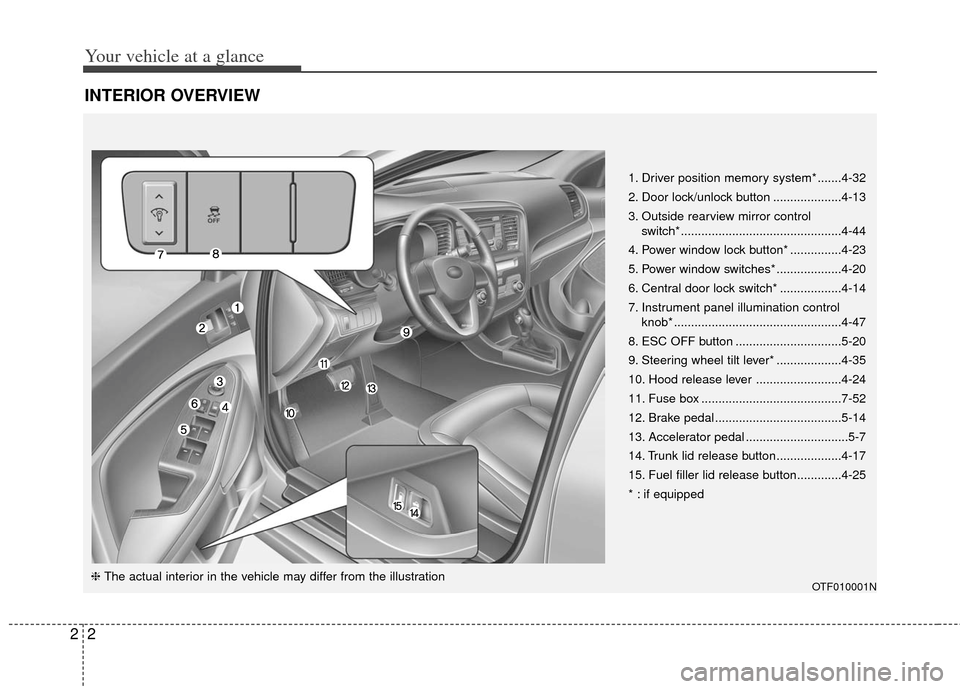
Your vehicle at a glance
22
INTERIOR OVERVIEW
1. Driver position memory system* .......4-32
2. Door lock/unlock button ....................4-13
3. Outside rearview mirror control switch* ...............................................4-44
4. Power window lock button* ...............4-23
5. Power window switches* ...................4-20
6. Central door lock switch* ..................4-14
7. Instrument panel illumination control knob* .................................................4-47
8. ESC OFF button ...............................5-20
9. Steering wheel tilt lever* ...................4-35
10. Hood release lever .........................4-24
11. Fuse box .........................................7-52
12. Brake pedal .....................................5-14
13. Accelerator pedal ..............................5-7
14. Trunk lid release button...................4-17
15. Fuel filler lid release button.............4-25
* : if equipped
OTF010001N❈ The actual interior in the vehicle may differ from the illustration
Page 12 of 394
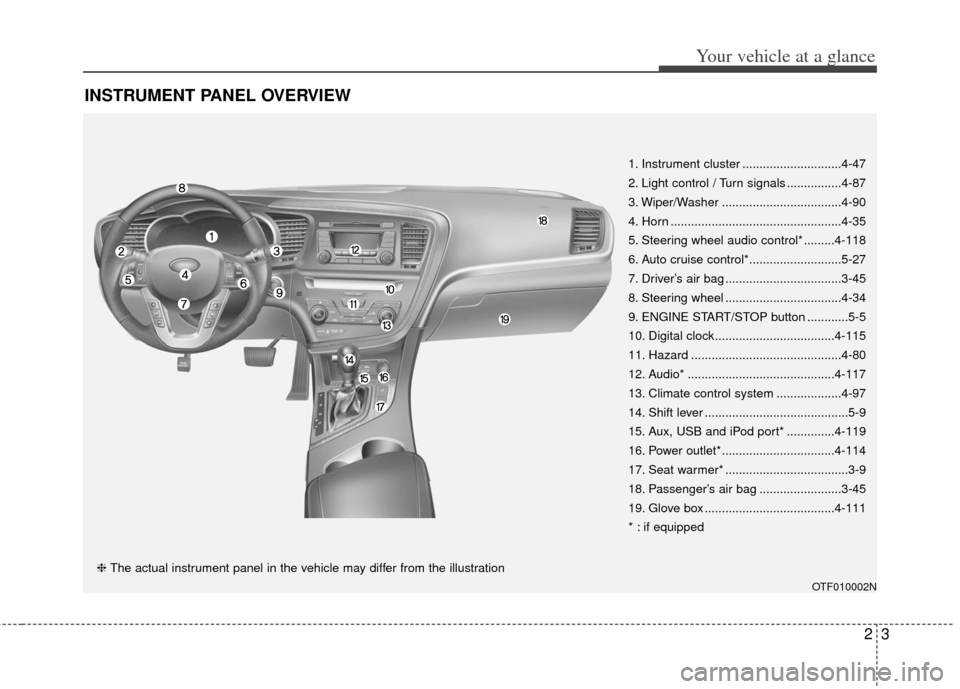
23
Your vehicle at a glance
INSTRUMENT PANEL OVERVIEW
OTF010002N
1. Instrument cluster .............................4-47
2. Light control / Turn signals ................4-87
3. Wiper/Washer ...................................4-90
4. Horn ..................................................4-35
5. Steering wheel audio control* .........4-118
6. Auto cruise control*...........................5-27
7. Driver’s air bag ..................................3-45
8. Steering wheel ..................................4-34
9. ENGINE START/STOP button ............5-5
10. Digital clock ...................................4-115
11. Hazard ............................................4-80
12. Audio* ...........................................4-117
13. Climate control system ...................4-97
14. Shift lever ..........................................5-9
15. Aux, USB and iPod port* ..............4-119
16. Power outlet* .................................4-114
17. Seat warmer* ....................................3-9
18. Passenger’s air bag ........................3-45
19. Glove box ......................................4-111
* : if equipped
❈ The actual instrument panel in the vehicle may differ from the illustration
Page 13 of 394
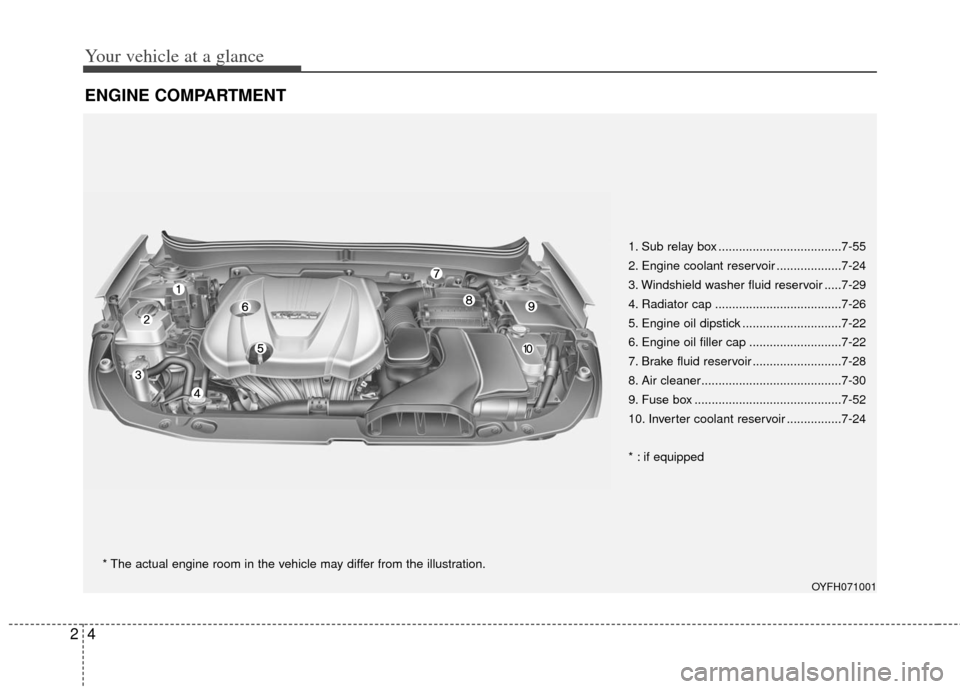
Your vehicle at a glance
42
ENGINE COMPARTMENT
1. Sub relay box ....................................7-55
2. Engine coolant reservoir ...................7-24
3. Windshield washer fluid reservoir .....7-29
4. Radiator cap .....................................7-26
5. Engine oil dipstick .............................7-22
6. Engine oil filler cap ...........................7-22
7. Brake fluid reservoir ..........................7-28
8. Air cleaner.........................................7-30
9. Fuse box ...........................................7-52
10. Inverter coolant reservoir ................7-24
* : if equipped
* The actual engine room in the vehicle may differ from the illustration.
OYFH071001
Page 14 of 394

25
Your vehicle at a glance
TRUNK OVERVIEW
OTFH021007N
1. Service plug.......................................H12
2. Battery cover.....................................7-35
3. Cooling duct ......................................H13
4. High voltage battery ............................H9
Page 15 of 394

3
Seat / 3-2
Seat belts / 3-16
Child restraint system / 3-26
Airbag-advanced supplemental restraint system / 3-34
Safety features of your vehicle
Page 16 of 394

Safety features of your vehicle
23
Driver’s seat
(1) Seat adjustment, forward / backward
(2) Seatback recliner
(3) Seat adjustment, height
(4) Lumbar support
(5) Driver position memory system*
(6) Seat warmer switch*
(7) Headrest
Front passenger’s seat
(8) Seat adjustment, forward / backward
(9) Seatback recliner
(10) Seat warmer switch*
(11) Headrest
Rear seat
(12) Seat warmer*
(13) Headrest
(14) Armrest
* : if equipped
SEAT
OTFH030001N
Page 17 of 394
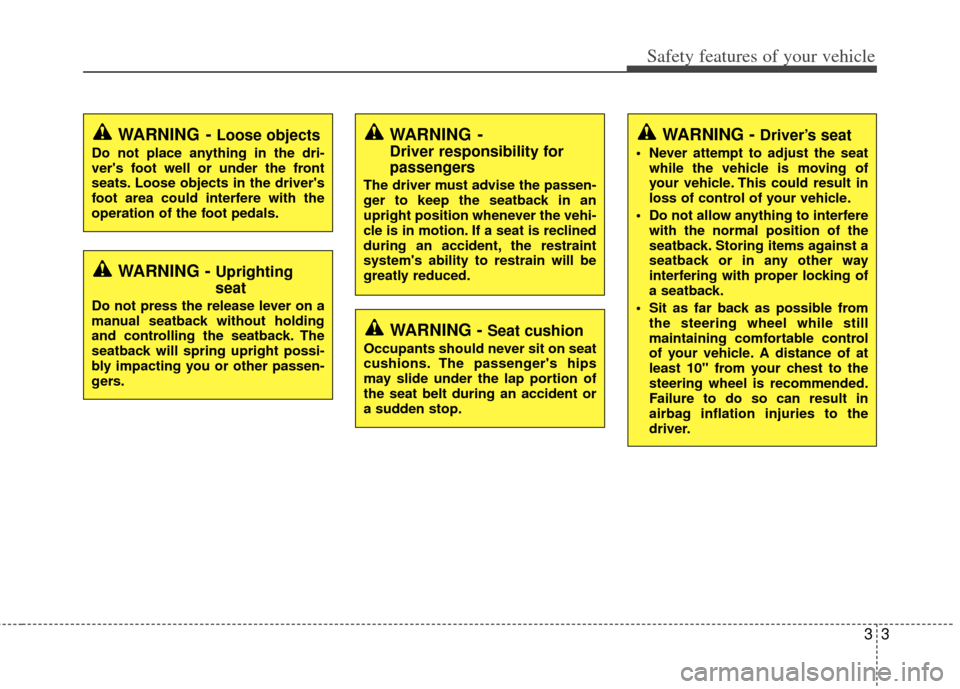
33
Safety features of your vehicle
WARNING - Driver’s seat
Never attempt to adjust the seatwhile the vehicle is moving of
your vehicle. This could result in
loss of control of your vehicle.
Do not allow anything to interfere with the normal position of the
seatback. Storing items against a
seatback or in any other way
interfering with proper locking of
a seatback.
Sit as far back as possible from the steering wheel while still
maintaining comfortable control
of your vehicle. A distance of at
least 10" from your chest to the
steering wheel is recommended.
Failure to do so can result in
airbag inflation injuries to the
driver.
WARNING - Uprighting
seat
Do not press the release lever on a
manual seatback without holding
and controlling the seatback. The
seatback will spring upright possi-
bly impacting you or other passen-
gers.
WARNING - Loose objects
Do not place anything in the dri-
ver's foot well or under the front
seats. Loose objects in the driver's
foot area could interfere with the
operation of the foot pedals.
WARNING -
Driver responsibility for
passengers
The driver must advise the passen-
ger to keep the seatback in an
upright position whenever the vehi-
cle is in motion. If a seat is reclined
during an accident, the restraint
system's ability to restrain will be
greatly reduced.
WARNING - Seat cushion
Occupants should never sit on seat
cushions. The passenger's hips
may slide under the lap portion of
the seat belt during an accident or
a sudden stop.
Page 18 of 394

Safety features of your vehicle
43
Front seat adjustment
Forward and backward
To move the seat forward or backward:
1. Pull the seat slide adjustment lever upand hold it.
2. Slide the seat to the position you desire.
3. Release the lever and make sure the seat is locked in place.
Adjust the seat before driving, and make
sure the seat is locked securely by trying
to move forward and backward without
using the lever. If the seat moves, it is not
locked properly.
WARNING - Seat
adjustment
Do not adjust the seat while wear- ing seat belts. Moving the seat
forward will cause strong pres-
sure on the abdomen.
Do not place your hand near the seat bottom or seat track while
adjusting the seat. Your hand
could get caught in the seat
mechanism.
WARNING - Unexpected
seat movement
After adjusting a manual seat,
always check that it is locked by
shifting your weight to the front and
back. Sudden or unexpected move-
ment of the driver's seat could
cause you to lose control of the
vehicle.
OTF030002
Page 19 of 394
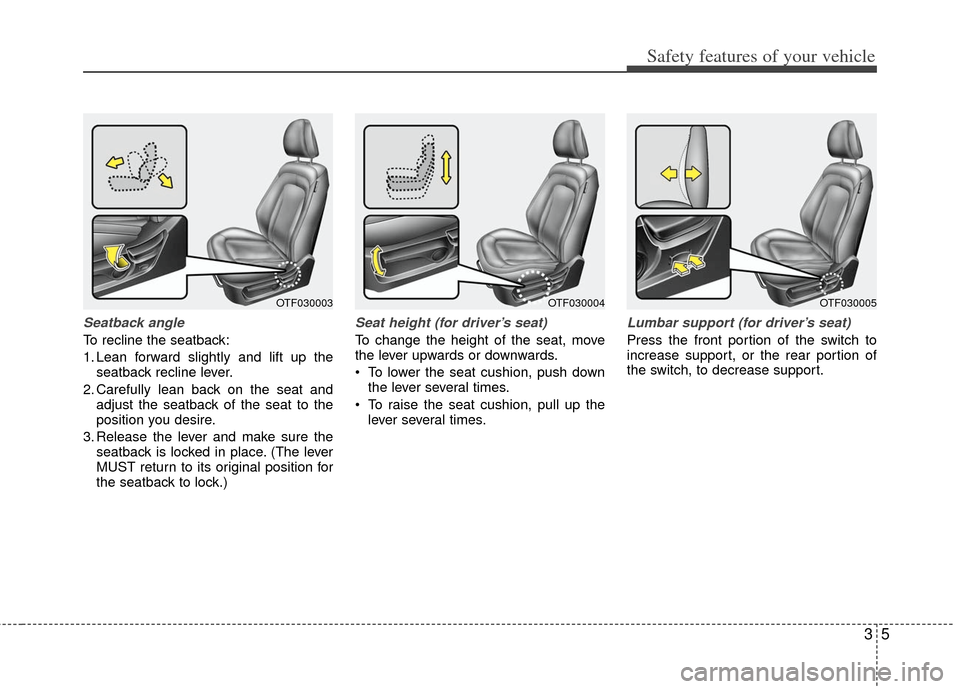
35
Safety features of your vehicle
Seatback angle
To recline the seatback:
1. Lean forward slightly and lift up theseatback recline lever.
2. Carefully lean back on the seat and adjust the seatback of the seat to the
position you desire.
3. Release the lever and make sure the seatback is locked in place. (The lever
MUST return to its original position for
the seatback to lock.)
Seat height (for driver’s seat)
To change the height of the seat, move
the lever upwards or downwards.
• To lower the seat cushion, push downthe lever several times.
To raise the seat cushion, pull up the lever several times.
Lumbar support (for driver’s seat)
Press the front portion of the switch to
increase support, or the rear portion of
the switch, to decrease support.
OTF030003OTF030004OTF030005
Page 20 of 394
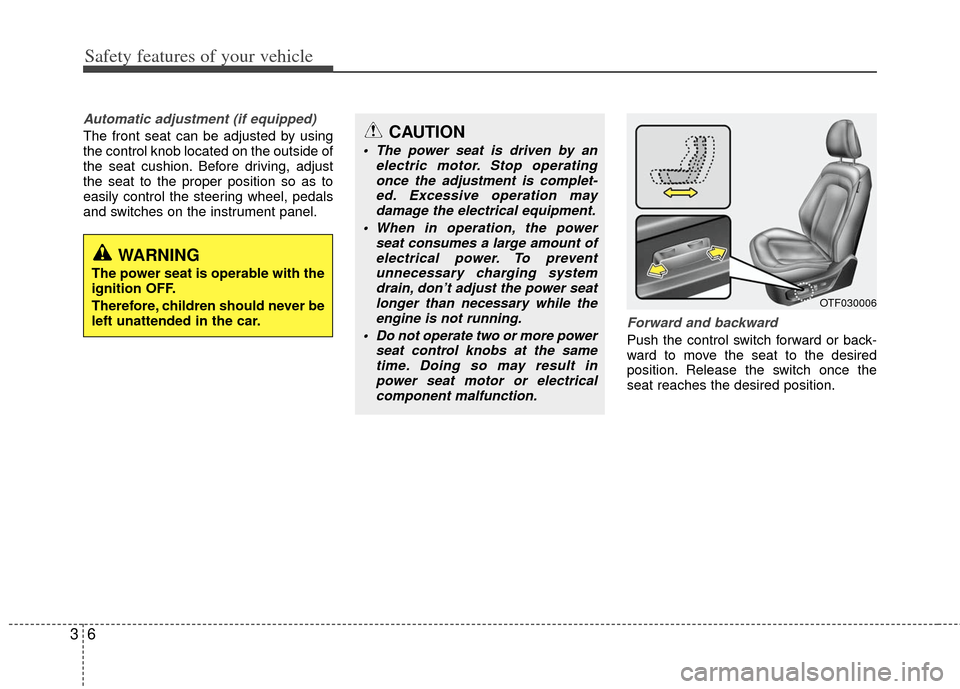
Safety features of your vehicle
63
Automatic adjustment (if equipped)
The front seat can be adjusted by using
the control knob located on the outside of
the seat cushion. Before driving, adjust
the seat to the proper position so as to
easily control the steering wheel, pedals
and switches on the instrument panel.
Forward and backward
Push the control switch forward or back-
ward to move the seat to the desired
position. Release the switch once the
seat reaches the desired position.
WARNING
The power seat is operable with the
ignition OFF.
Therefore, children should never be
left unattended in the car.
CAUTION
The power seat is driven by anelectric motor. Stop operatingonce the adjustment is complet-ed. Excessive operation maydamage the electrical equipment.
When in operation, the power seat consumes a large amount ofelectrical power. To preventunnecessary charging systemdrain, don’t adjust the power seatlonger than necessary while theengine is not running.
Do not operate two or more power seat control knobs at the sametime. Doing so may result inpower seat motor or electricalcomponent malfunction.
OTF030006